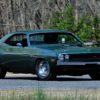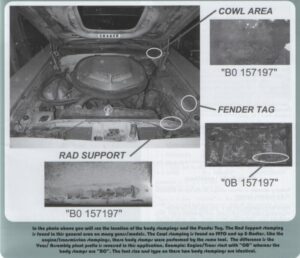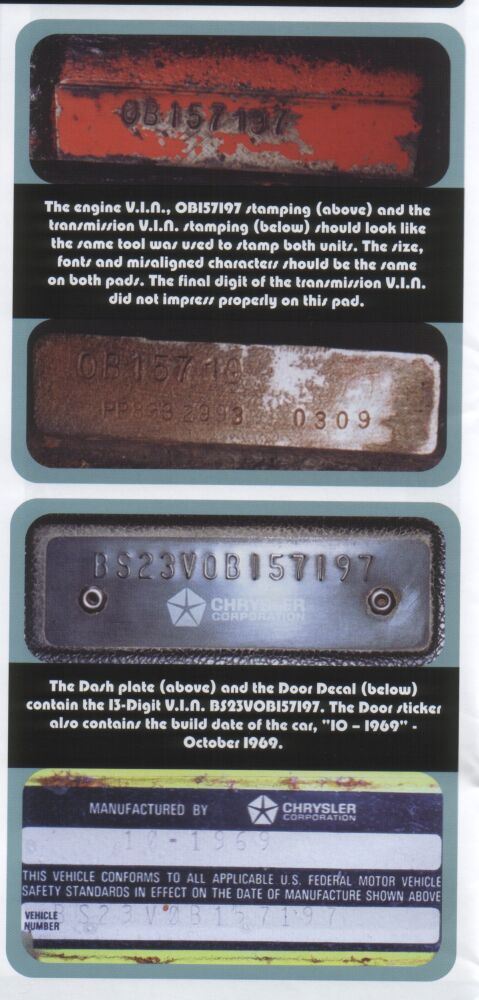How To De-Code Your Vehicle Identification Number (VIN)
The most important documentation to come with your Challenger is its vehicle identification number. You can use this number to check how rare or original your vehicle really is. It would be easy to take, say, a 1970 318 model worth a few thousand Dollars and drop in a Hemi engine and sell it for tens of thousands of Dollars if it were not for the VIN.
The VIN is a thirteen-digit number which is stamped, whole or in part, in various places on the car making it very difficult for anyone to sell the car as something it is not.
The first and main place to find the VIN is on a plate attached to the edge of the dash pad on the driver’s side and is visible through the windshield. All 13 digits will be here.
The second main place is on the metal tag attached to the top of the driver’s side inner fender. This tag also has many of the codes that identify the options that originally came with the car. Again all 13 digits will be marked.
The VIN can also be found on a label, attached to the rear face of the driver’s door near the striker, that also has the date of manufacture and certifies that the car conforms to federal safety regulations.
The last 8 digits of the VIN are also stamped into the body in one or more of these places depending on where it was built. The radiator support, the cowl, rear package tray, convertible cross brace, rear body behind the bumper and (although I have never heard of anyone finding one on a Challenger) on the left-hand trunk weather-stripping rail. Note that the plant and date code digits (first two of the last eight) exchange places when stamped into the body.
Chrysler also took the trouble to stamp the last eight digits of the VIN on the engine and transmission. A car that has the same number stamped in all of these places is referred to as a “numbers matching” car.

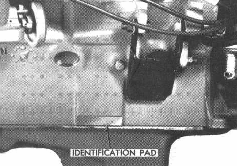
The location of the ID pads on the 6 cyl. (left) and V8 (right) engines
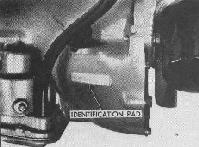
and on the auto transmission
The manual trans has a VIN pad in the same place.
The numbers should look like this although these examples are from a Barracuda;
Your decoded VIN is displayed below:
Making sense of the numbers
First digit
The first digit in the VIN is the car line. For a Challenger this is the letter “J”
Second digit
This is the price class. The 1970-71 Challenger R/T and 1972 Rallye have the letter “S” (for Special). All others (including the 1973-4 Rallye) have the letter “H” (for High). The Challenger Deputy is reported to have been “L” (for Low) but examples seen seem to have the “H” instead.
Third and fourth digits
This tells us the body type.
23 = Two door hardtop
27 = Convertible
29 = Special Edition car (with the small rear window)
Again there is some confusion as to the Challenger Deputy. The 1971 ordering guide lists it as JL21 but they are known to be stamped JH23.
Fifth digit
This is the engine code:
B = 198 ci (1970-71 only)
C = 225 ci (1970-72 only)
G = 318 ci (All years)
H = 340 ci (1970-73 only)
J = 340 ci six pack (1970 only)
L = 360 ci (1974 only)
L = 383 ci (1970-71 only)
N = 383 ci High power (1970-71 only)
R = 426 ci Hemi (1970-71 only)
U = 440 ci (1970 only)
V = 440 ci six pack (1970-71 only)
Sixth digit
This is the last digit of the model year (Not necessarily the year of manufacture)
e.g. 0 = 1970, 1 = 1971, etc.
Seventh digit
This is the assembly plant code. Challengers were built at two plants in the U.S.
B = Dodge Main, Hamtramck, MI (all models)
E = Los Angeles, CA (no hemi cars or convertibles)
Hamtramck had two production lines. The R/T cars mostly seem to have been built on line #2.
The last six digits
This is the plant sequential production number starting with the number 100001. It is NOT an indication of the number of Challengers built!


